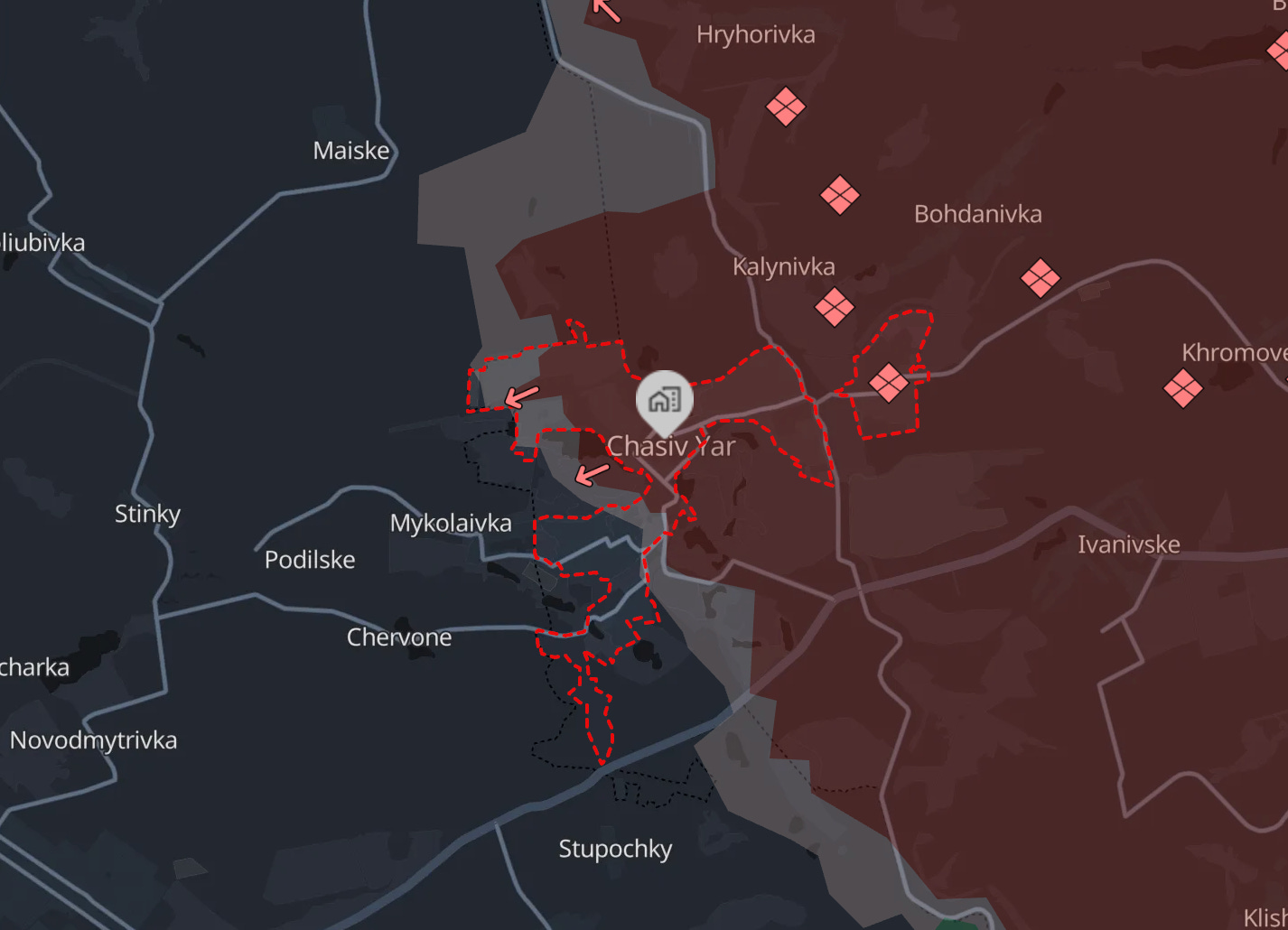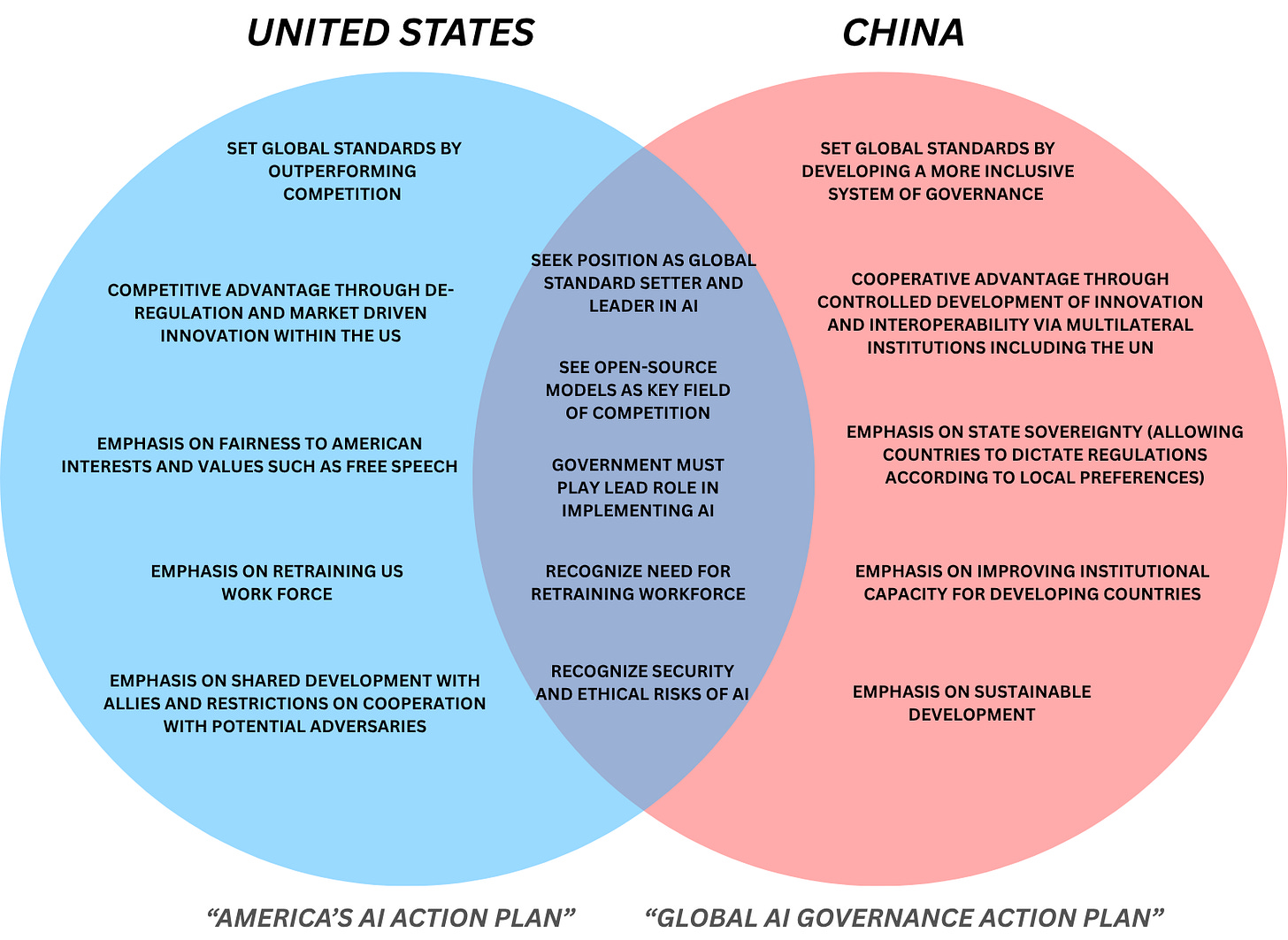Weekly Significant Activity Report - August 2, 2025
China unveils its global vision for AI, Russia claims capture of strategic Ukrainian city but faces new threats to its oil exports, Iran and North Korea defy US demands to denuclearize.
This week's analysis highlights some of the most significant news concerning America's adversaries between July 26, 2025 - August 2, 2025.
Summary:
China unveils its vision for global AI development days after the US announces its own plan.
Russia claims capture of the Ukrainian stronghold of Chasiv Yar.
Russian fossil fuel exports come under a new threat after Indian refiners stop buying amid the threat of US tariffs.
Iran suggests it is preparing to leave the Nuclear Non-Proliferation Treaty (NPT) in response to a potential snapback of sanctions at the end of August.
North Korea announces interest in renewed dialogue with the US if Washington recognizes it as a nuclear state.
1. AI RACE BETWEEN CHINA AND THE US HEATS UP
From July 26-28 China hosted the World Artificial Intelligence Conference (WAIC) 2025. There Chinese leaders announced an “Action Plan on Global Governance of Artificial Intelligence.” The announcement came less than two days after the White House announced its own strategic plan for AI entitled “Winning the AI Race: America’s AI Action Plan.”
Takeaways:
The public plans provide contours of different strategies which are illustrated below:
However, these documents serve fundamentally different purposes. The US document functions as a comprehensive policy framework, outlining strategic recommendations and concrete goals for government and industry to advance American interests and maintain competitive advantage in AI, including detailed information about global strategic positioning. In contrast, the Chinese plan reads more as a promotional document than a detailed policy blueprint.
The tone of China's 'Action Plan' emphasizes cooperation and global harmony, but other Xi Jinping-era documents, including the 2017 “New Generation Artificial Intelligence Development Plan” and presumably many internal policy documents, outline AI development objectives that are just as ruthlessly competitive as America's.
Like the United States, China seeks to leverage AI to secure global leadership through enhanced military capabilities, increased economic productivity, and dominance in research and innovation. Central to both countries' strategies is cementing leadership by becoming the global standard-setter for AI governance and development.
However, unlike the US, China's ambitions are fundamentally revisionist in character. China aims to use AI governance not merely to compete within the existing international order, but to establish new global norms that advance its strategic interests. The most important of these interests is ensuring the continued dominance of the Chinese Communist Party.
China’s goal in leading the creation of AI standards is to tilt the global information environment away from Western pluralism and openness toward the concept of cyber state-sovereignty. Cyber state-sovereignty is a plan for creating separate but interoperable information operating systems across different societies. This is appealing to China, whose internet is closed, heavily surveilled, and aggressively censored to protect the country’s political regime. Beijing aims to use its influence in setting AI standards to help countries develop their own systems using Chinese technology that promotes favorable information about China while suppressing negative views of the country.
2. RUSSIA CLAIMS NEW ADVANCES IN DONETSK
This week the Russian military claimed the full capture of the Ukrainian city of Chasiv Yar. Chasiv Yar is a small city (pre-war population of less than 15,000) in northern Donetsk Oblast. The city has often been considered strategically significant due to its elevated position which overlooks larger cities to the west such as Kostiantynivka.
Kyiv has denied that Ukrainian forces have been forced out of the city.
Takeaways:
The capture of Chasiv Yar, if it did occur, would be mostly a symbolic victory at this point. Russia has controlled the key districts of the city since July 2024, and the vast majority of the city since late winter. As a result, the value of any gains derived from capturing the city in full has already long been realized.
Russian officials and media will tout the capture of Chasiv Yar as evidence of fresh momentum to strengthen their negotiating position. But it is important to note that Russia’s initial goal was to seize the city by May 9, 2024. The slow and costly campaign (which may not yet even be finished) is instead fresh evidence of how wide the gulf is between Russia’s ambitions and its capabilities.
Prominent Russian milblogger Rybar noted the length and cost of the battle to warn against over optimism in a July 31 post on Telegram:
“📌 As for the further development of the offensive on Konstantinovka from the east, before that, several more small settlements will have to be occupied, which are surrounded by an extensive system of fortifications. And about Druzhkovka, about which overly optimistic talk has already begun, it will hardly be necessary to talk at all this year.
“⚡️The battles for Chasov Yar lasted more than 16 months, and Konstantinovka is three times larger in area, although it is located in a lowland, the Ukrainian Armed Forces will be able to transfer reinforcements there from Kramatorsk through Druzhkovka and Alekseevka-Druzhkovka through an almost continuous agglomeration.”
Open-source mapping from Deep State suggests that Russia controls most but not all of the city.1 The debate over what constitutes a full capture of the city is influenced in part because of the unusual shape of the city’s boundaries.

Assessed frontline in the vicinity of Chasiv Yar. Source: Deep State Map, August 1, 2025
3. RUSSIAN FOSSIL FUEL EXPORTS COME UNDER NEW PRESSURE
Russian oil exports down in 2025
According to a July 29 report by Bloomberg, Russian oil exports are down 30 million barrels so far this year, a decline of 4%.
Indian refiners stop buying Russian oil
Multiple reports suggest that Indian state refiners have paused purchases of Russian oil. On July 31, Reuters reported that Indian Oil Corp, Hindustan Petroleum Corp, Bharat Petroleum Corp and Mangalore Refinery Petrochemical Ltd had all ceased purchases of Russian crude over the past week. This follows a July 30 report from Bloomberg that the Indian government had asked refiners to develop plans to replace Russian oil to avoid US secondary sanctions.
Takeaways:
The potential loss of Indian markets for Russian oil presents a very serious strategic dilemma for the Kremlin. Revenue from fossil fuel exports accounts for about a third of Russia’s state budget. Loss of income from oil exports would add to a growing budget deficit and deteriorating economic conditions in the country (See Weekly Significant Activity Report - July 19, 2025 for more information on the worsening economic indicators).
India has become the third largest importer of Russian oil after the start of the war in Ukraine, scooping up Russian crude at a discount, and helping Russia replace markets it had lost in Europe.
Further complicating matters for Russia is an expected production hike by OPEC+. As many as eight members of the group plan to announce production increases as early as Sunday, August 3. The new oil reaching the market will help India substitute Russian imports and depress demand for Russian Urals crude even further.
The prospect of losing additional oil revenue adds to a week of other troubling economic news for Russia. Russian financial consultancy group Frank RG reported that eight of Russia’s 20 largest banks reported a drop in deposits in June, despite lucrative interest rates exceeding 18%. The IMF also lowered its projections for Russia’s 2025 GDP growth from an earlier estimate of 1.5% to 0.9%.
4. IRAN HINTS AT LEAVING THE NUCLEAR NON-PROLIFERATION TREATY IN RESPONSE TO NEW SANCTIONS
Iranian President Masoud Pezeshkian and Iranian Oil Minister Mohsen Paknejad both announced this week that Iran is ready for the return of enhanced sanctions under the 2015 Joint Comprehensive Plan of Action (JCPOA) snapback mechanism. The announcement comes as Iran faces pressure to come to a new deal with the US and European signatories of the JCPOA (France, Germany and the UK) prohibiting uranium enrichment by the end of August or face sanctions snapback.
Iran’s Foreign Ministry Spokesman Esmaeil Baghaei hinted that an Iranian response to a snapback of sanctions would include the country’s withdrawal from the Nuclear Non-Proliferation Treaty (NPT).
"We have emphasized that this means is ineffective and the European parties have questioned the validity of Resolution 2231 [by their threats.] If this mechanism is used, Iran will respond, and we hope that the opposite parties will realize the risks and avoid complicating the situation."
"We will remain a member of the NPT on the condition that we enjoy our rights under this treaty, including the right to enrich."
Takeaways:
Iran has few good options for coping with the intense Western pressure to drop its nuclear program. Its options for waiting out Western demands will be limited by the resumption of sanctions which will hamper its ability to dedicate the significant resources it will take to rebuild its nuclear program. Withdrawing from the NPT amid a massive rebuilding of its nuclear program would be seen as a threatening gesture by the US and Israel and would likely invite further attacks.
Iran, which consulted with representatives from China and Russia last week in Vienna, would receive some initial diplomatic and economic support from both countries in any confrontation with the US. However, both Beijing and Moscow would ultimately find it difficult to defend Iran’s withdrawal from the NPT over the long-term.
Still, the Iranian regime can’t be seen as backing down from threats from the West. Threatening to withdraw from the NPT is one of the few major, though largely symbolic, diplomatic moves Iran has at its disposal. The brinkmanship may ultimately lead to Tehran’s withdrawal from the pact under the assumption that the country can rejoin at a later date and extract concessions for doing so.
5. NORTH KOREA ANNOUNCES OPENNESS TO DIALOGUE WITH THE US, DISINTEREST IN RECONCILIATION WITH SOUTH KOREA
Kim Yo-Jong, sister and top lieutenant of North Korean Supreme Leader Kim Jong-un, announced on North Korean state media that dialogue with the US is still possible. She suggested that positive personal relations between Kim Jong-un and US President Donald Trump could be a starting point for renewed dialogue but stated that any engagement needed to be preceded by US acceptance of North Korea as a nuclear state.
Kim Yo-Jong also stated that North Korea was not interested in a similar dialogue with the new government in South Korea.
“We clarify once again the official stand that no matter what policy is adopted and whatever proposal is made in Seoul, we have no interest in it and there is neither a reason to meet nor an issue to be discussed with.”
Source: North Korea Now and Yonhap News Agency on YouTube
Takeaways:
President Trump has made multiple comments in the first few months of his second administration suggesting a de facto recognition of North Korea’s nuclear arsenal. North Korean leaders are testing the receptivity of the Trump administration to new dialogue under such an understanding. However, the official policy of the Trump administration appears to be hardening against any recognition of nuclear proliferation in the wake of its strikes on Iran’s nuclear program.
Kim Yo-Jong’s declaration of disinterest in dialogue with the South comes as a rebuff to confidence-building gestures implemented by recently elected South Korean president Lee Jae-myung. These gestures included curbing anti-Pyongyang leaflet drops and loudspeaker messaging along the demilitarized zone.
Deep State Map is a Ukrainian open source mapping project. While Deep State is partnered with the Ukrainian Ministry of Defense, it receives information from a variety of sources and is considered to be a reliable tool for assessing the frontline positions of the Russian military and the direction of Russian advances.





